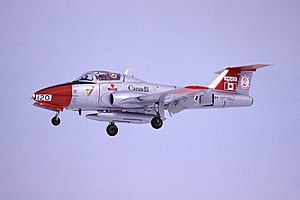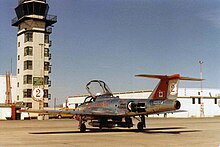
Canadair Ltd. was a civil and military aircraft manufacturer in Canada. In 1986, its assets were acquired by Bombardier Aerospace, the aviation division of Canadian transport conglomerate Bombardier Inc.
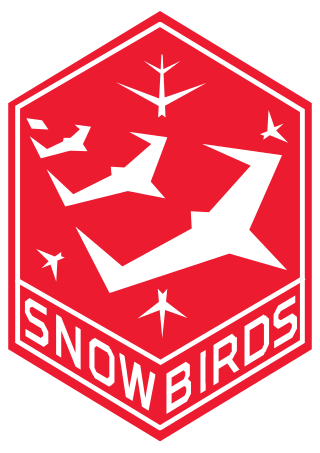
The Snowbirds, officially known as 431 Air Demonstration Squadron, are the military aerobatics flight demonstration team of the Royal Canadian Air Force. The team is based at 15 Wing Moose Jaw near Moose Jaw, Saskatchewan. The Snowbirds' official purpose is to "demonstrate the skill, professionalism, and teamwork of Canadian Forces personnel". The team also provides a public relations and recruiting role, and serves as an aerial ambassador for the Canadian Armed Forces. The Snowbirds are the first Canadian air demonstration team to be designated as a squadron.

The Royal Canadian Air Force is the air and space force of Canada. Its role is to "provide the Canadian Forces with relevant, responsive and effective airpower". The RCAF is one of three environmental commands within the unified Canadian Armed Forces. As of 2020, the Royal Canadian Air Force consists of 12,074 Regular Force and 1,969 Primary Reserve personnel, supported by 1,518 civilians, and operates 258 manned aircraft and nine unmanned aerial vehicles. Lieutenant-General Eric Kenny is the current commander of the Royal Canadian Air Force and chief of the Air Force Staff.

The Golden Hawks were a Royal Canadian Air Force (RCAF) aerobatic flying team established in 1959 to celebrate the 35th anniversary of the RCAF and the "Golden" 50th anniversary of Canadian flight, which began with the AEA Silver Dart in 1909.
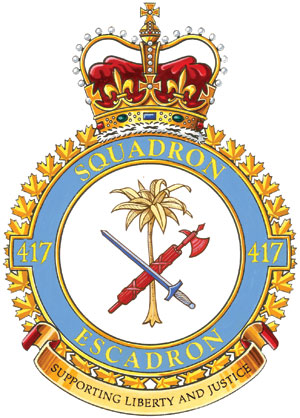
417 Combat Support Squadron is an Air Force unit with the Canadian Forces. Based at CFB Cold Lake it provides helicopter support to the base operations. Since 1994, it has also provided search and rescue.

The Canadair CT-133 Silver Star is the Canadian license-built version of the Lockheed T-33 jet trainer aircraft, in service from the 1950s to 2005. The Canadian version was powered by the Rolls-Royce Nene 10 turbojet, whereas the Lockheed production used the Allison J33.

The Canadair CF-104 Starfighter is a modified version of the Lockheed F-104 Starfighter supersonic fighter aircraft built in Canada by Canadair under licence. It was primarily used as a ground attack aircraft, despite being designed as an interceptor. It served with the Royal Canadian Air Force (RCAF) and later the Canadian Armed Forces (CAF) until it was replaced by the McDonnell Douglas CF-18 Hornet.
NATO Flight Training in Canada (NFTC) is a military flight training program for NATO and allied air forces provided by the Canadian Forces.

Canadian Forces Base Moose Jaw, also known as 15 Wing Moose Jaw, is a Canadian Forces base located 4 nautical miles south of Moose Jaw, Saskatchewan. It is operated as an air force base by the Royal Canadian Air Force (RCAF) and is home to RCAF Pilot training and 431 Squadron, the Snowbirds, which is the RCAF's air demonstration squadron.
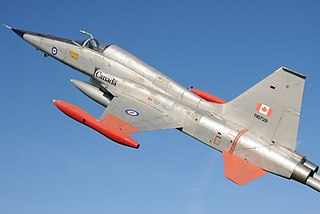
The Canadair CF-5 is a Canadian licensed-built Northrop F-5 Freedom Fighter. It is a light, supersonic, twin engine, daylight air superiority fighter primarily for the Canadian Forces and the Royal Netherlands Air Force. The CF-5 was upgraded periodically throughout its service life in Canada. While Canadian Forces retired the aircraft in 1995, it continues to be used by other countries.
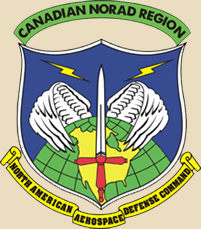
Canadian Forces Base Winnipeg is a Royal Canadian Air Force base located within the City of Winnipeg, Manitoba. Co-located at the Winnipeg James Armstrong Richardson International Airport, CFB Winnipeg is home to many flight operations support divisions, as well as several training schools. Its primary RCAF lodger unit is 17 Wing, commonly referred to as 17 Wing Winnipeg.

The Beechcraft CT-134 Musketeer is a military training derivative of the Musketeer built by Beechcraft for the Canadian Armed Forces. The CT-134 was a single engine, low-wing, four-seat light aircraft with fixed landing gear and a limited aerobatic capability.

2 Canadian Forces Flying Training School is one of the Royal Canadian Air Force's training centres for pilots and also one of the facilities of the NATO Flying Training in Canada (NFTC) program.

The Cold Lake Air Force Museum is a military aviation museum located in Cold Lake, Alberta. The museum preserves and exhibits the heritage and history of 4 Wing Cold Lake and 42 Radar Squadron. The Air Force Museum is actually one of four museums based on the old site of 42 Radar Squadron, who re-located to CFB Cold Lake in 1992. The Cold Lake Museums are connected to the Air Force Museum through a covered hallway affectionately dubbed 'The Tunnel'. All together, the museums are referred to as the Cold Lake Museums or the Tri-City Museums. The old facility of 42 Radar Squadron was decommissioned in 1992, and the museum opened its doors for the first time on July 1, 1998.

The National Air Force Museum of Canada is an aviation museum dedicated to preserving the history of the Royal Canadian Air Force (RCAF) and is located on the west side of CFB Trenton in Trenton, Ontario.

The Shearwater Aviation Museum is an aviation museum located at CFB Shearwater in Shearwater, Nova Scotia. The museum acquires, conserves, organizes, researches and interprets to Canadian Forces personnel and the public at large for their study, education and enjoyment, artifacts and documents which exemplify the history of Canadian maritime military aviation.
Lt. Col (Ret.) Joseph Armand Gerard Fernand Villeneuve was a Canadian aviator who joined the Royal Canadian Air Force (RCAF) in 1950 and was the first leader of the RCAF's Golden Hawks aerobatic team. He flew for 32 years as a military jet fighter pilot Villeneuve was inducted into the Canadian Aviation Hall of Fame in 2006.
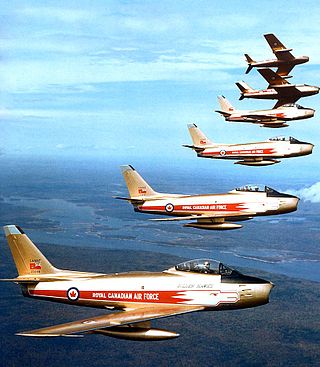
James David McCombe was a Royal Canadian Air Force (RCAF) pilot who was a commander of the Golden Hawks aerobatics team. His career with the RCAF spanned 23 years.

On April 8, 1954 Trans-Canada Air Lines Flight 9, a Canadair C-4 North Star four-engine commercial propliner on a domestic regular scheduled flight, collided in mid air with a Royal Canadian Air Force (RCAF) Harvard Mark II single engine military trainer on a cross-country navigation exercise over Moose Jaw, Saskatchewan.
This is the structure of the Royal Canadian Air Force, as of November 2020.
